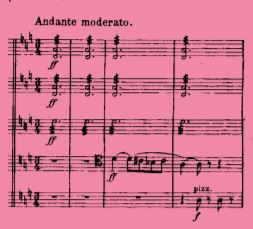Carmen overture finishes with a mysterious and unexpected musical theme (a motif) which is meant to represent both Carmen as well as the concept of “fate.” This theme will appear many times during the opera, usually accompanying the main character and important events in the plot.
According to Wikipedia, “In music, a motif is a short musical idea, a salient recurring figure, musical fragment or succession of notes that has some special importance in or is characteristic of a composition”. When a motif is associated to a character, place, idea.. it is called leitmotif and may be heard whenever that character is on stage or that idea is an important part of the plot.
In Carmen this Motif is one of the most recognizable musical motives of the opera. It is a short musical phrase used to mark the action of Carmen and her destiny (Fate Motif).
In the opera you can hear it fir the first time at the end of the prelude but ut will return several times in connection to Carmen’s action on stage forboding her tragic end.
The Fate Motif in Carmen is composed of :
- a fortissimo tremolo
- a chromatic melodic line
- two foreboding low notes layed by the double bass and bass drum.
In music we can find other Fate Motif in other pieces. Beethoven achieved the highest elaboration of this technique; the famous “fate motif” —the pattern of three short notes followed by one long one—that opens his Fifth Symphony and reappears throughout the work in surprising and refreshing permutations is a classic example.
- Symphony No. 5 (Beethoven)
- Symphony No. 6 (Mahler)
- Pelleas und Melisande (Schoenberg)
- Symphony No. 8 (Shostakovich)
- Oboe Concerto (Strauss)
- Symphony No. 4 (Tchaikovsky)
- La forza del destino (opera by Verdi)
- Die Walküre (opera by Richard Wagner)



.png)





















